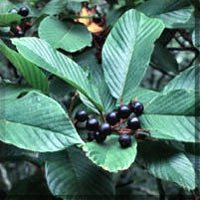
Rhamnus purshiana

Rhamnus purshiana
Origin - Pacific Northwest
Description - Rhamnus are a genus (or two genera, if Frangula is treated as distinct) of about 100 species of shrubs or small trees from 1-10 m tall (rarely to 15 m), in the buckthorn family Rhamnaceae. They are native throughout the temperate and subtropical Northern Hemisphere, and also more locally in the subtropical Southern Hemisphere in parts of Africa and South America. It can grow as a tree to 50 feet tall and 10 to 20 inches in diameter or as an erect shrub with multiple stems to 15 feet.
Part of the plant used - Dried bark
History - Cascara sagrada, "sacred bark" in Spanish, is a deciduous shrub or small tree from the buckhorn family with a distinctive reddish gray bark. The name dates back to the 17th century when the Native Americans introduced the Spanish and Mexican explorers to the usefulness of the bark for constipation and stomach upset. The bark was first marketed to the medical community in 1877 as a bitter emetic fluid extract. In 1890 the plant was officially listed in the U. S. Pharmacopoea.
Pharmacology - Cascara bark is high in hydroxyanthraquinone glycosides called cascarosides. Resins, tannins, and lipids make up the bulk of the other bark ingredients. Cascarosides have a cathartic action, inducing the large intestine to increase its muscular contraction (peristalsis), resulting in bowel movement. The basis of Cascara's laxative effect is the presence of a mixture of anthraquinones, either free (aloe-emodin) or as sugar derivatives (glycosides). The free anthraquinones remain in the intestines and cause catharsis by irritating the intestinal wall. Those anthraquinones present in the plant as sugar derivatives are largely absorbed from the intestine, circulate through the blood stream, and eventually stimulate the nerve center in the lower part of the intestine, which causes a laxative effect. No synthetic substance can match the mild and speedy action of the holy bark. It is marketed in pills, powders, and fluidextracts by many pharmaceutical companies.
Medicinal Uses: Purgative, bitter tonic. Cascara is useful for the treatment of Constipation. It is one of the oldest, time-proven, and most reliable remedies for chronic constipation. It is not habit forming. It is a good intestinal tonic. An excellent remedy for gallstones and increases the secretion of bile. Good for liver complaints; especially enlarged liver. Aqueous extracts of Cascara have been found to be antiviral against herpes Simplex virus II and vaccinia virus in cell culture.
Toxicity, Cautions & Contra-indications - Only Rhamnus purshiana that has been aged properly should be used. Fresh Rhamnus purshiana bark contains chemicals that may cause severe vomiting. Rhamnus purshiana works by irritating the lining of the gastrointestinal tract. For most individuals, this irritation is minor. However, it can worsen inflammatory bowel conditions such as Crohn's disease and irritable bowel syndrome. No toxicity at 50-100mg. Takes from six to eight hours to produce stool. Cathartic effect at very high doses. Should not be used by nursing mothers since the laxative effect will be transmitted to their infants. Should not be used by people suffering from ulcers or irritable bowel syndrome.